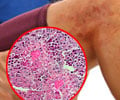It has been reported that bacteria lurking in household dust is sufficient enough to produce chemicals called endotoxins that may trigger asthma and asthma-related symptoms such as wheezing.
A strong association has been established between endotoxin levels and the prevalence of diagnosed asthma, asthma symptoms, asthma medication use, and wheezing. These relationships were strongest for bedroom floor and bedding dust. Households with higher endotoxin concentrations experienced higher prevalence of respiratory symptoms.Endotoxins are substances released by micro-organisms when there the membrane surrounding it ruptures or disintegrates. Because bacteria can be found everywhere in the home, the likelihood of their release is high. Once released, endotoxins can cause inflammation of the airways and lead to asthma symptoms.
Dust samples were collected from bedroom, kitchen and living room floors, bedding, and upholstered furniture and assayed for endotoxin.
When the dust samples were analyzed, kitchen and living room floors were found to harbor highest concentrations of endotoxin. Furthermore, it was found that the likelihood of having recent asthma symptoms was nearly three times greater among individuals with exposure to high levels of endotoxin in the bedroom.
The researchers found that all dust samples contained detectable levels of endotoxin. The average concentration of endotoxin ranged from 80.5 units per milligram of dust on kitchen floors to 18.7 on bedding. Family room floors had endotoxin concentrations of 63.9 units per milligram of dust; sofas had concentration levels at 44.8; and 35.3 units on bedroom floors.
"Interestingly, endotoxin exposure worsens asthma symptoms in adults, regardless of whether an individual has allergies or not. This suggests that exposure to endotoxin increases asthma risk even in non-allergic individuals “said Peter S. Thorne, a senior researcher involved in the study.
Advertisement
Understanding how factors such as duration of exposure, timing of the exposure, and genetic factors, contribute to the development of diseases like asthma will lead to new insights into how to prevent and treat this important disease.











